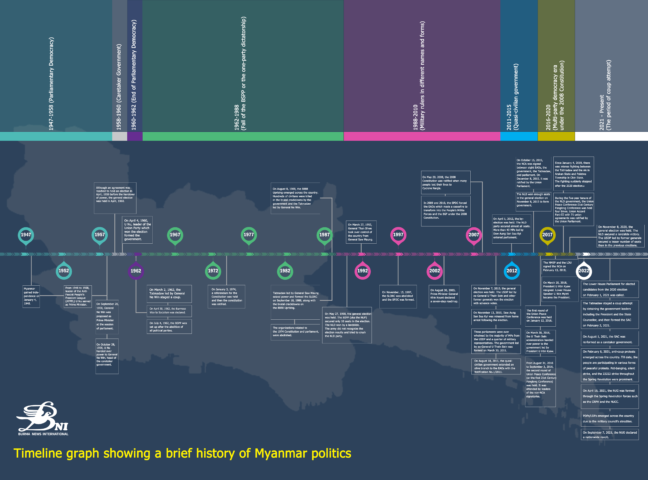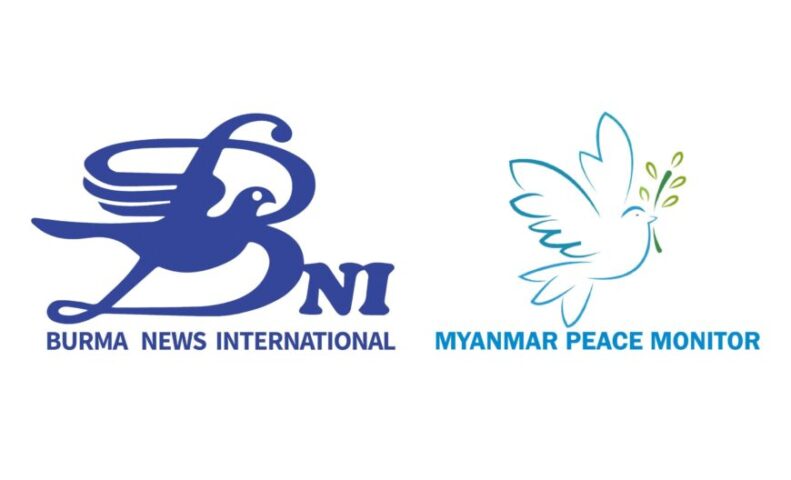
A Brief History of Myanmar Politics
Under the 1947 Constitution, Myanmar people were able to enjoy parliamentary democracy since the country gained its independence on January 4, 1948 and up till 1958. Since the handover of power to the caretaker government led by General Ne Win on September 28, 1958, the army has led the country throughout the history of Myanmar politics. Now, it is difficult to think about the country’s politics by removing the role of the army.
General Ne Win’s caretaker government which promised to conduct the general election within six months could hold the polls only in April, 1960. The caretaker government handed over power to the Union Party led by U Nu who won the election. On March 2, 1962, the army led by General Ne Win seized power over the country. On April 30, 1962, the army declared the Burmese Way to Socialism and then abolished all political parties. On July 4, 1962, the army established the Burma Socialist Programme Party (BSPP).
The 1947 Constitution was abolished on January 3, 1974. Then, the new 1974 Constitution was ratified with the referendum. The 8888 Uprising emerged across the country on August 8, 1988. The BSPP government led by General Ne Win and its cohort carried out violent crackdowns, shootings, arrests, and killings of monks, students, and the public who defied them. Hundreds of civilians were killed in these brutal crackdowns. The result was that the socialist era (or the one-party dictator era) came to an end.
On September 18, 1988, the army led by General Saw Maung seized control of the country. Then, the army formed the State Law and Order Restoration Council (SLORC) and abolished organizations such as the parliament, judiciary body, and administrative body pertaining to the 1974 Constitution. On May 27, 1990, the general election was held with the participation of the National Unity Party (NUP), the National League for Democracy (NLD), and more than 90 political parties.
Despite the NLD’s landslide victory in the election, the army did not recognize the election results and instead tried to crush the party with acts of terror such as killing and sentencing NLD leaders and party members, and driving a wedge between them.
On March 27, 1992, General Than Shwe took over control of the country from General Saw Maung. On November 15, 1997, the SLORC was abolished and reconstituted as the State Peace and Development Council (SPDC). On August 30, 2003, Prime Minister General Khin Nyunt declared a seven-step roadmap. On May 29, 2008, the 2008 Constitution which was drafted through the National Convention in Nyaung Hanapin of Hlegu Township in Yangon Region, was ratified. In 2009, the SPDC forced the Ethnic Revolutionary Organizations (EROs) which made the ceasefire, to transform into the People’s Militia Forces or the Border Guard Forces (BGF), citing the 2008 Constitution. Some EROs transformed into the People’s Militia Forces and the BGF. There were persistent tensions as some EROs such as the Kachin Independence Army (KIA) opposed the army’s pressures.
On November 7, 2010, the general election was held. The Union Solidarity and Development Party (USDP) led by the ex-general and Prime Minister U Thein Sein and former generals won the election. On November 13, 2010, NLD leader Daw Aung San Suu Kyi was released from house arrest after the election. On January 31, 2011, the SPDC called the first regular session of the Lower House Parliament according to the 2008 Constitution.
On March 30, 2011, the quasi-civilian government led by U Thein Sein was formed. On August 18, 2011, it announced Notification No.1/2011, extending an olive branch to the Ethnic Armed Organizations (EAOs). On April 1, 2012, the NLD led by Daw Aung San Suu Kyi participated in the by-election in which the NLD secured almost all seats. More than 40 members of parliament (MPs) from the NLD were elected. On October 15, 2015, eight EROs signed the Nationwide Ceasefire Agreement (NCA) with the government, the Tatmadaw, and parliament. On December 8, 2015, it was ratified by the Union Parliament.
On January 12, 2016, the Union Peace Conference which arose from the NCA was held. On March 30, 2016, control of the country was handed over to the government led by President U Htin Kaw from the NLD which secured the majority of seats in the 2015 general election.
During the tenure of the government led by President U Htin Kyaw, on August 31, 2016, the second Union Peace Conference was held under the name of the 21st Century Panglong Conference. The first 21st Century Panglong Conference was attended by the leaders of the EROs which had not signed the NCA. The speeches delivered by the EROs leaders were broadcast live.
On February 13, 2018, the NCA was signed between the New Mon State Party (NMSP), the Lahu Democratic Union (LDU), the government, Tatmadaw, and parliament. On March 21, 2018, President U Htin Kyaw retired and Lower House Speaker U Win Myint became the new President. The Union Peace Conference-21st Century Panglong Conference was held only four times during the five-year tenure of the NLD government. 71 agreements and three sections of the Union Accord Part III were approved. These Union Accords were ratified by the Union Parliament.
On January 4, 2019, the Arakan Army (AA) attacked four border police camps in Buthidaung Township. There was intense fighting between the army and the AA in Arakan State and Paletwa of Chin State. Fighting suddenly stopped following the election held on November 8, 2020.
The NLD achieved a landslide victory in the 2020 general election. The USDP secured a smaller number of seats in the election compared to that in 2010 and 2015. The USDP and its allied parties met with regime leader Senior General Min Aung Hlaing. In a meeting with pro-military parties, the regime leader said, “There was nothing I wouldn’t dare do”.
At dawn, just few hours before the fourth regular session of the Lower House was due to commence on February 1, 2021, the army led by Senior General Min Aung Hlaing attempted a coup by detaining the President, the State Counsellor, cabinet members, the NLD’s top leaders, and prominent politicians. On February 2, 2021, the military council formed the State Administration Council (SAC). On August 1, 2021, the military council formed the caretaker government.
On the opposing end, more than 300 elected candidates from the 2020 general election formed a 15-member Committee Representing Pyidaungsu Hluttaw (CRPH) on February 5, 2021 through a Zoom meeting. The total number of the CRPH members increased to 20 when some elected candidates from the Kayah State Democratic Party (KySDP), the Ta’ang National Party (TNP), and the Kachin State People’s Party (KSPP) were added to the list, in addition to the NLD candidates.
Since February 6, 2021, anti-coup protests have arisen across the country. Till date, the public is still participating in peaceful protests in various forms. Anti-coup movements such as pot-banging, silent strike, and the 22222 strike were prominent.
On March 31, 2021, the CRPH announced that it abolished the 2008 Constitution and approved the Federal Democratic Charter. Under the Federal Democratic Charter, the National Unity Consultative Council (NUCC) emerged. On April 16, 2021, the formation of an interim National Unity Government (NUG) proposed by the NUCC was declared. As a result of the military council’s atrocities, the People’s Defense Forces (PDFs) and the Local Defense Forces (LDFs) mushroomed across the country. On September 7, 2021, the NUG’s Acting President declared a nationwide revolt against the military council.
